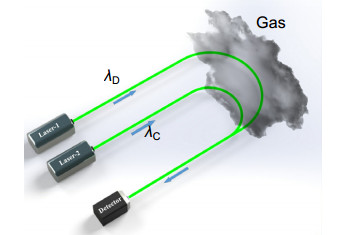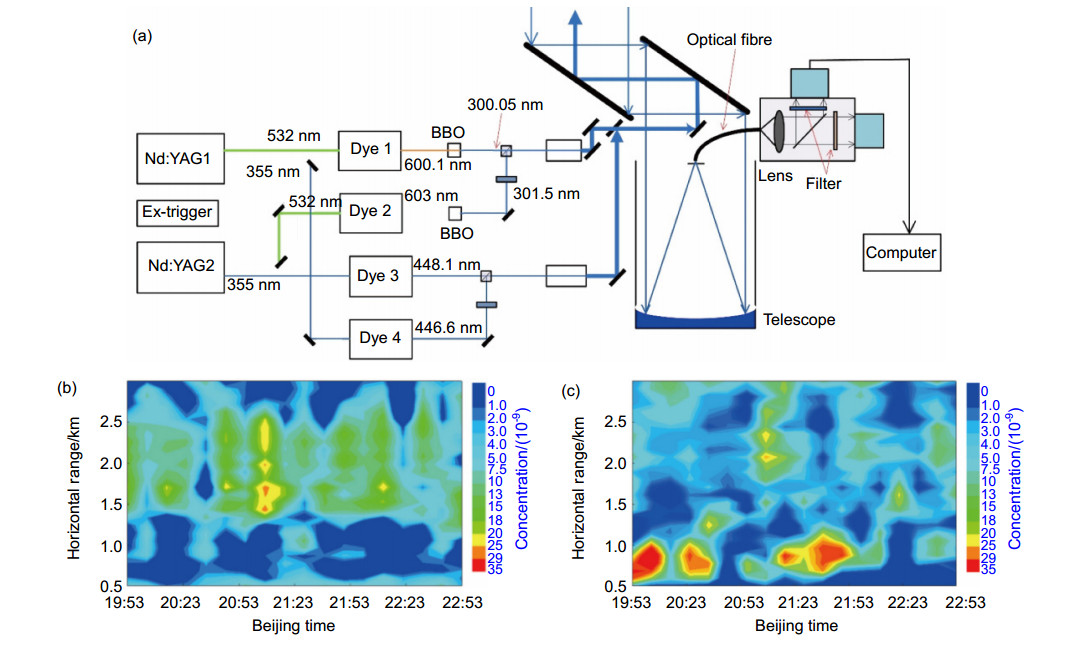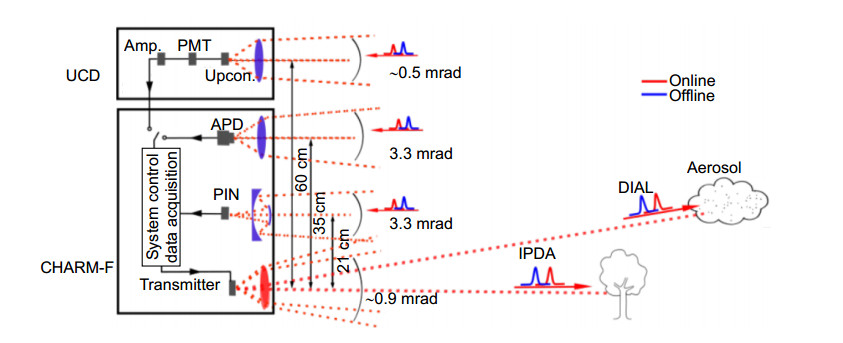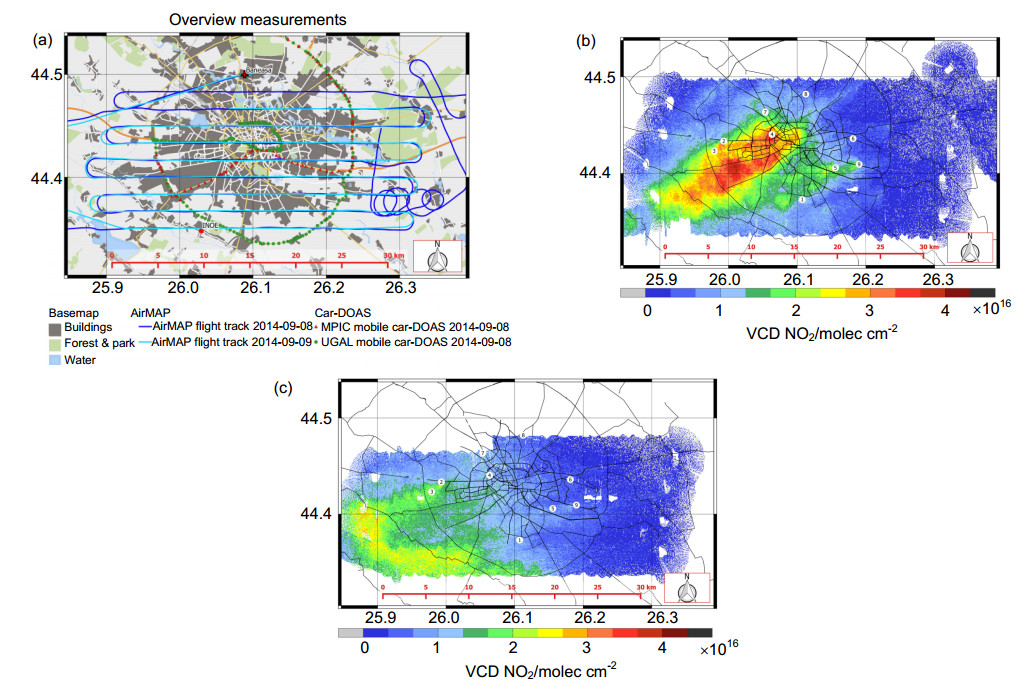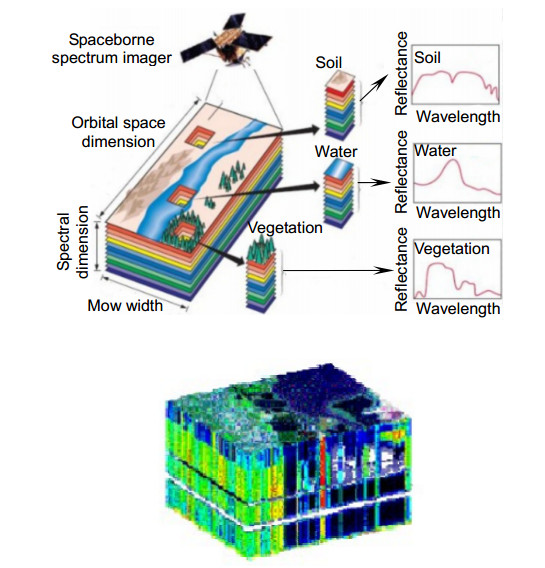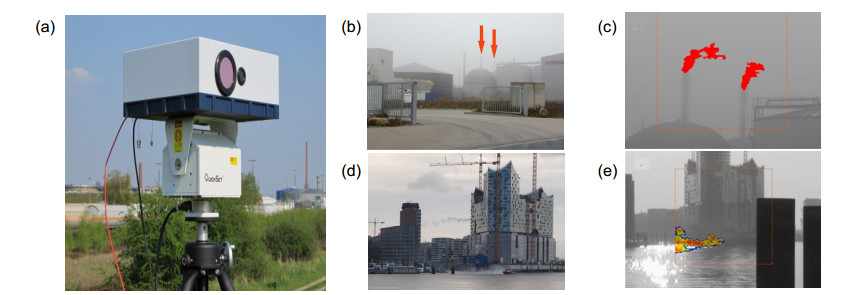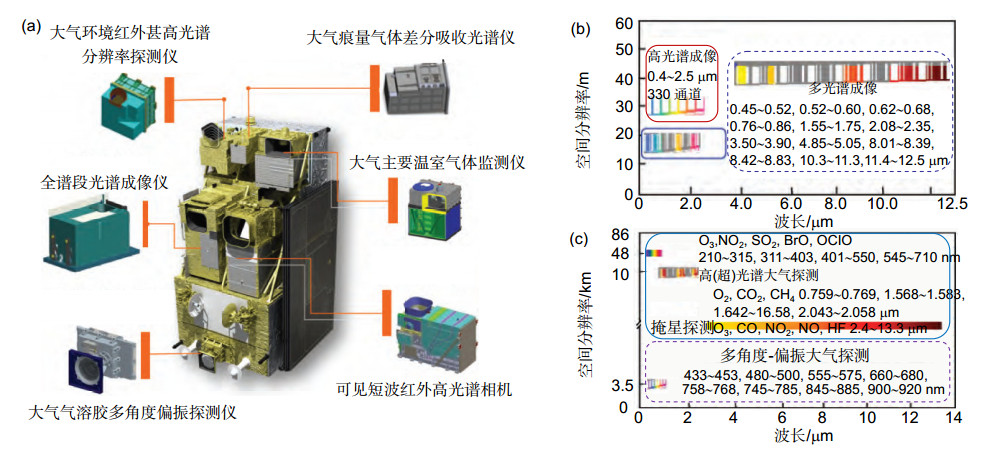-
摘要:
气体的快速识别与检测已成为国内外研究者迫切解决的重大问题。随着光学技术的快速发展,气体光学检测技术以其高效率、多组分、高灵敏度等显著优势而成为气体检测领域的重要研究热点之一。本文介绍了气体光学检测技术的理论基础,并按主动式与被动式两大类综述了各种典型气体光学检测技术的工作原理及应用进展。运用这些气体检测技术,已经对几十种气体实现远距离、高灵敏度的连续实时监测,完成了多种场景下对气体成分、浓度、温度等参数的测量,有效减少了危险事故的发生。通过总结和分析现有气体光学检测技术仍存在的技术问题,对未来的发展趋势进行了展望。
Abstract:Rapid identification and detection of gases is a major problem that needs to be solved urgently by researches from worldwide. With the development of optical technology, optical gas detection technology has attracted great attention due to its remarkable advantages of high efficiency, multi-component detection ability and high sensitivity. In this paper, the theoretical foundation of optical gas detection technology is first introduced. Then the working principles and applications of various optical detection technologies for typical gases according to active and passive detection are reviewed. Using these gas detection technologies, dozens of gases have been continuously monitored at long distance with high sensitivity. The measurements of gas composition, concentration, temperature and other parameters in a variety of scenarios are realized, which effectively reduces the occurrence of dangerous accidents. By summarizing and analyzing the technical problems that still exist in the current optical gas detection technology, the future development trend is prospected.
-

Overview: With the development of economy, human demands for chemical materials are increasing. Although these chemical materials provide great convenience and improvement to our daily lives, gas leakage accidents in various fields happen frequently. Leakage of the commonly used flammable and explosive gases such as liquefied petroleum gas, methane and vinyl chloride may cause explosions or fires. Gas leakage accidents not only cause huge economic losses, but also can cause casualties. In addition, some non-toxic, odorless and seemingly harmless gases can also cause great harm to the environment. For example, SF6 gas, which is commonly used in power systems, and gases such as CO2 emitted in production will cause the greenhouse effect, resulting global warming. Therefore, developing gas detection technology that can achieve rapid, qualitative and quantitative identification and detection of harmful gases in various scenarios has become an urgent problem for researchers. With the development of spectral imaging technology, the spectroscopy method develops rapidly. Compared with the traditional gas detection method, the spectroscopy method does not require sample preparation, and is fast, non-invasive, highly-efficient and dynamic, thus suitable for rapid and continuous detection in various fields. Accordingly, the spectroscopy method has become a hot spot of research and application in various countries.
This paper first introduces the theoretical foundation of optical gas detection technology, and then reviews the working principle and application of various optical detection technologies for typical gases according to active and passive detection. Active detection methods include tunable diode laser absorption spectroscopy (TDLAS), differential absorption LiDAR (DIAL), differential optical absorption spectroscopy (DOAS), etc. Passive detection methods include remote sensing Fourier transform infrared spectroscopy (RS-FTIR) and spectral imaging (SI). This paper focuses on the applications of optical gas detection methods mentioned above. In order to facilitate a deeper understanding of the application fields of each technology, we have detailed the types of gases, accuracy, detection limits, volume and cost that can be detected in each technical, and the latest application results of each technology are introduced in detail. Using these gas detection technologies, continuous and real-time monitoring with long distance and high sensitivity for dozens of gases have been achieved, measurements of composition, concentration, temperature and other parameters of gases in a variety of scenarios have been realized, thus effectively reducing the appearances of dangerous accidents. The future development tendency of optical gas detection technologies is prospected after summarizing and analyzing the existing technologies and their problems.
-

-
图 8 基于UCD的激光雷达测量装置[30]
Figure 8. Laser radar measuring device based on upconversion detector[30
图 10 NO2测量法及结果。(a)布加勒斯特地图与测量概述;蓝色线代表测量轨迹,绿色圆点和红色三角形代表测量位置;(b)第一天测得的几何修正后的NO2垂直柱密度;(c)第二天测得的几何修正后的NO2垂直柱密度[34]
Figure 10. Measurement method and results of NO2. (a) Map of Bucharest with an overview of the measurements; Blue lines show the flight tracks, Circles and triangles mark the measurement locations; (b) Vertical column densities measured on first day; (c) Vertical column densities measured on second day[34]
图 12 近地面大气CO2测量系统。(a)车载OP-FTIR光谱仪及应用场景;(b)西南点CO2浓度分布极坐标图;(c)中心点CO2浓度分布极坐标图[50]
Figure 12. Integrative investigations of near-ground surface atmospheric CO2 conditions. (a) Application of the vehicle-mounted OP-FTIR spectrometer in different land; (b) Polar plot of the horizontal distribution of path integrated CO2 concentration measured at the southwestern point; (c) Polar plot of the horizontal distribution of path integrated CO2 concentration measured at the central point[50]
图 16 高分五号载荷及工作谱段。(a)高分五号载荷配置;(b)高分五号对地成像谱段;(c)高分五号大气探测谱段[69]
Figure 16. Payloads configuration and spectral characteristics of GF-5. (a) Payloads configuration of GF-5 satellite; (b) Spectral characteristics of earth imaging instrument for GF-5; (c) Spectral characteristics of atmosphere sounding for GF-5[69]
表 1 典型气体光学检测技术对比
Table 1. Comparison of typical gas optical detection techniques
名称 优点 缺点 工作波段 应用领域 主动式检测 可调谐二极管激光吸收光谱 环境适应性强;
选择性强;
易于小型化;
结果无需标定光源波长范围小;
可同时测量气体种类少近红外波段:
(0.73 μm~3 μm);
中红外波段:
(2 μm~15 μm)大气环境监测;
工业过程检测;
流场诊断差分吸收激光雷达 测量结果偏差较小;
信噪比高;
可三维监测;
远距离遥感测量易受大气折射率湍流的影响;
受人眼安全和可靠性的限制紫外波段:
(1.4 μm~4.2 μm)大气气溶胶云映射、云雾测量;
污染气体测量;
天然气排放检测差分吸收光谱 系统实时性好;
价格便宜;
光程上的线测量易受随机噪声干扰;
点位选取要求苛刻;
安装复杂紫外波段:
(0.19 μm~0.5 μm);
可见光波段:
(0.55 μm~0.7 μm)大气在线监测;
脱硫脱硝;
电厂烟气排放;
对NOX、SO2和O3检测效果显著被动式检测 被动式遥感傅里叶变换红外光谱 无分光元件;
处理速度快;
无需光谱扫描;
可同时测量污染物种类多易产生相位误差;
傅里叶变换计算耗时;
干净环境中痕量气体测量时灵敏度低;
系统需冷却近红外波段:
(0.75 μm~3 μm);
中红外波段
(3.3 μm~40 μm);
远红外波段
(40 μm~330 μm)污染物发射率测量;
腐蚀性气体测量;
温度和烟气测量;
温室气体测量;
挥发性有机物(VOCs)测量光谱成像 光谱分辨率极高;
连续的地物光谱信息;
极高的探测和识别能力;
可探测被测物的状态参量系统结构复杂;
数据量庞大;
图像处理步骤复杂;
空间分辨率较低紫外、可见光、近红外和中红外波段
(0.24 μm~12.5 μm)军事侦察识别;
温室气体监测;
水体监测;
植被识别;
资源勘探;
海洋遥感表 2 三种光谱成像技术比较
Table 2. Comparison of three spectral imaging techniques
多光谱成像 高光谱成像 超光谱成像 波段数 ≤10 10~100 100~1000 光谱分辨率 0.1 cm-1 0.01 cm-1 ≤0.001 cm-1 图谱 分离 合一 合一 通道连续性 不连续 连续 合一 表 3 我国星载高光谱遥感技术
Table 3. Technology of spaceborne-based hyperspectral remote sensing of our country
名称 空间外差光谱仪 碳卫星 风云三号 高分五号 特点 光通量大;
无运动部件,结构简单;
集成度高,重量轻;
功耗小采样率高;
可观测气溶胶;
检测精准度高;
可靠性和稳定性较好反演精度高;
光谱通道数量较多;
光谱定标精度高光谱分辨率高;
探测范围大;
可定量化探测;
信噪比高相关参数 光谱范围:
6325 cm-1~6360 cm-1;
光谱分辨率:0.27 cm-1;
信噪比:500可工作在760 nm, 1610 nm, 2060 nm特征波段;
光谱分辨率:0.04 nm光谱范围:0.69 µm ~15.0 µm;
地面分辨率:0.25 km~4 km;
扫描范围:±49.5°最高空间分辨率:20 m;
可见光谱段光谱分辨率:5 nm;
红外光谱段光谱分辨率:0.03 cm-1应用范围 大气中CO2的探测 大气中CO2和气溶胶的探测 大气温室气体(CO、CO、CH4等)的探测 陆表生态环境监测、资源调查及地质填图等 时间 2010年 2016年 2017年 2018年 -
[1] 罗淑芹.基于TDLAS的CO2气体检测分析系统[D].哈尔滨: 哈尔滨工业大学, 2013.
Luo S Q. Detection and analysis system for CO2 gas based on TDLAS[D]. Harbin: Harbin Institute of Technology, 2013.
http://cdmd.cnki.com.cn/Article/CDMD-10213-1014001047.htm [2] 刘文清, 崔志成, 董凤忠.环境污染监测的光学和光谱学技术[J].光电子技术与信息, 2002, 15(5): 1-12. http://d.old.wanfangdata.com.cn/Periodical/gdzjsyxx200205001
Liu W Q, Cui Z C, Dong F Z. Optical and spectroscopic techniques for environmental pollution monitoring[J]. Optoelectronic Technology & Information, 2002, 15(5): 1-12. http://d.old.wanfangdata.com.cn/Periodical/gdzjsyxx200205001
[3] 施文.有毒有害气体检测仪器原理和应用[M].北京:化学工业出版社, 2009.
Shi W. The Principle and Application of Hazardous Gas Detectors[M]. Beijing: Chemical Industry Press, 2009.
[4] 王帅, 冯新泸.多组分气体检测与识别技术进展[J].重庆工学院学报(自然科学版), 2007, 21(3): 78-81, 87. doi: 10.3969/j.issn.1674-8425-B.2007.03.023
Wang S, Feng X L. Development of multigas analysis and identifying technology[J]. Journal of ChongQing Institute of Technology (Natural Science Edition), 2007, 21(3): 78-81, 87. doi: 10.3969/j.issn.1674-8425-B.2007.03.023
[5] 聂伟, 阚瑞峰, 杨晨光, 等.可调谐二极管激光吸收光谱技术的应用研究进展[J].中国激光, 2018, 45(9): 0911001. http://www.wanfangdata.com.cn/details/detail.do?_type=perio&id=zgjg201809001
Nie W, Kan R F, Yang C G, et al. Research progress on the application of tunable diode laser absorption spectroscopy[J]. Chinese Journal of Lasers, 2018, 45(9): 0911001. http://www.wanfangdata.com.cn/details/detail.do?_type=perio&id=zgjg201809001
[6] Claps R, Englich F V, Leleux D P, et al. Ammonia detection by use of near-infrared diode-laser-based overtone spectroscopy[J]. Applied Optics, 2001, 40(24): 4387-4394. doi: 10.1364/AO.40.004387
[7] Flanigan D F. Limits of passive remote detection of hazardous vapors by computer simulation[J]. Proceedings of SPIE, 1996, 2763: 117-127. doi: 10.1117/12.243272
[8] Hinkley E D. Tunable infra-red lasers and their applications to air pollution measurements[J]. Opto-Electronics, 1972, 4(2): 69-86. doi: 10.1007/BF01421173
[9] Schiff H I, Mackay G I, Bechara J. The use of tunable diode laser absorption spectroscopy for atmospheric measurements[J]. Research on Chemical Intermediates, 1994, 20(3-5): 525-556. doi: 10.1163/156856794X00441
[10] 刘秀, 王岭雪, 金伟其, 等.危险气体泄漏的光学遥测技术及其进展[J].红外技术, 2009, 31(10): 563-567, 572. doi: 10.3969/j.issn.1001-8891.2009.10.002
Liu X, Wang L X, Jin W Q, et al. The development of optical remote measurement for hazardous gas leakage[J]. Infrared Technology, 2009, 31(10): 563-567, 572. doi: 10.3969/j.issn.1001-8891.2009.10.002
[11] Reid J, Labrie D. Second-harmonic detection with tunable diode lasers — Comparison of experiment and theory[J]. Applied Physics B, 1981, 26(3): 203-210.
[12] Chen P, Gang C, Tang J P, et al. High-speed mid-infrared frequency modulation spectroscopy based on quantum cascade laser[J]. IEEE Photonics Technology Letters, 2016, 28(16): 1727-1730. doi: 10.1109/LPT.2016.2554359
[13] Deguchi Y, Kamimoto T, Wang Z Z, et al. Applications of laser diagnostics to thermal power plants and engines[J]. Applied Thermal Engineering, 2014, 73(2): 1453-1464. doi: 10.1016/j.applthermaleng.2014.05.063
[14] Wang J, Yu D H, Ye H J, et al. Applications of optical measurement technology in pollution gas monitoring at thermal power plants[J]. Proceedings of SPIE, 2011, 8197: 819702. doi: 10.1117/12.917948
[15] Liu S Y, Tao Z, Jia X D. Towards aerial natural gas leak detection system based on TDLAS[J]. Proceedings of SPIE, 2014, 9299: 92990X. http://www.wanfangdata.com.cn/details/detail.do?_type=perio&id=CC0214801406
[16] Deng J, Chen W L, Wang W F, et al. Study on online detection method of methane gas in coal mine based on TDLAS technology[M]//Wang X T. Proceedings of the 11th International Mine Ventilation Congress. Singapore: Springer, 2019.
[17] He C G, Zhang Y J, Chen C, et al. Signal detection circuit design of HCN measurement system based on TDLAS[J]. Proceedings of SPIE, 2016, 10157: 1015710. http://www.wanfangdata.com.cn/details/detail.do?_type=perio&id=HYCIC201606120000001518
[18] Yin W, Wei Y B, Chang J, et al. Tunable diode laser absorption spectroscopy- based detection of propane for explosion early warning by using a vertical cavity surface enhanced laser source and principle component analysis approach[J]. IEEE Sensors Journal, 2017, 17(15): 4975-4982. doi: 10.1109/JSEN.2017.2713769
[19] He Q X, Zheng C T, Liu H F, et al. A near-infrared acetylene detection system based on a 1.534 μm tunable diode laser and a miniature gas chamber[J]. Infrared Physics & Technology, 2016, 75: 93-99.
[20] Wang Y, Nikodem M, Zhang E, et al. Shot-noise limited faraday rotation spectroscopy for detection of nitric oxide isotopes in Breath, Urine and Blood[J]. Scientific Reports, 2015, 5: 9096. doi: 10.1038/srep09096
[21] Gonzalez-Valencia R, Magana-Rodriguez F, Gerardo-Nieto O, et al. In situ measurement of dissolved methane and carbon dioxide in freshwater ecosystems by off-axis integrated cavity output spectroscopy[J]. Environmental Science & Technology, 2014, 48(19): 11421-11428. http://www.wanfangdata.com.cn/details/detail.do?_type=perio&id=b053a2fa4fc28e5b39f2f12fdf4c859d
[22] Xia H H, Kan R F, Xu Z Y, et al. Measurements of axisymmetric temperature and H2O concentration distributions on a circular flat flame burner based on tunable diode laser absorption tomography[J]. Proceedings of SPIE, 2016, 10156: 101560S.
[23] Pan R, Jeffries J B, Dreier T, et al. Measurements of liquid film thickness, concentration, and temperature of aqueous urea solution by NIR absorption spectroscopy[J]. Applied Physics B, 2016, 122(1): 4. doi: 10.1007/s00340-015-6290-y
[24] 胡欢陵, 王志恩, 吴永华, 等.紫外差分吸收激光雷达测量平流层臭氧[J].大气科学, 1998, 22(5): 701-708. doi: 10.3878/j.issn.1006-9895.1998.05.04
Hu H L, Wang Z E, Wu Y H, et al. UV-DIAL system for measurements of stratospheric ozone[J]. Chinese Journal of Atmospheric Sciences, 1998, 22(5): 701-708. doi: 10.3878/j.issn.1006-9895.1998.05.04
[25] 胡顺星, 陈亚峰, 刘秋武, 等.差分吸收激光雷达系统探测背景大气SO2和NO2[J].中国激光, 2018, 45(9): 113-118. http://www.wanfangdata.com.cn/details/detail.do?_type=perio&id=zgjg201809009
Hu S X, Chen Y F, Liu Q W, et al. Differential absorption lidar system for background atmospheric SO2 and NO2 measurements[J]. Chinese Journal of Lasers, 2018, 45(9): 113-118. http://www.wanfangdata.com.cn/details/detail.do?_type=perio&id=zgjg201809009
[26] Singh U N, Yu J R, Petros M, et al. Development of a pulsed 2-micron integrated path differential absorption lidar for CO2 measurement[J]. Proceedings of SPIE, 2013, 8872: 887209. doi: 10.1117/12.2028245
[27] Singh U N, Refaat T F, Petros M, et al. Evaluation of 2-μm pulsed integrated path differential absorption lidar for carbon dioxide measurement—technology developments, measurements, and path to space[J]. IEEE Journal of Selected Topics in Applied Earth Observations and Remote Sensing, 2018, 11(6): 2059-2067. doi: 10.1109/JSTARS.2017.2777453
[28] Gibert F, Edouart D, Cénac C, et al. 2-μm Ho emitter-based coherent DIAL for CO2 profiling in the atmosphere[J]. Optics Letters, 2015, 40(13): 3093-3096. doi: 10.1364/OL.40.003093
[29] Amediek A, Ehret G, Fix A, et al. CHARM-F-a new airborne integrated-path differential-absorption lidar for carbon dioxide and methane observations: measurement performance and quantification of strong point source emissions[J]. Applied Optics, 2017, 56(18): 5182-5197. doi: 10.1364/AO.56.005182
[30] Meng L C, Fix A, Wirth M, et al. Upconversion detector for range-resolved DIAL measurement of atmospheric CH4[J]. Optics Express, 2018, 26(4): 3850-3860. doi: 10.1364/OE.26.003850
[31] Platt U, Perner D, Pätz H W. Simultaneous measurement of atmospheric CH2O, O3, and NO2 by differential optical absorption[J]. Journal of Geophysical Research: Oceans, 1979, 84(C10): 6329-6335. doi: 10.1029/JC084iC10p06329
[32] 姚建铨, 李润宸, 赵帆, 等.基于DOAS的消防应急救援多气体快速遥感仪[J].光电子·激光, 2018, 29(3): 314-317. http://www.wanfangdata.com.cn/details/detail.do?_type=perio&id=gdzjg201803012
Yao J Q, Li R C, Zhao F, et al. Fast multi-gas remote monitor based on DOAS for fire emergency rescue[J]. Journal of Optoelectronics Laser, 2018, 29(3): 314-317. http://www.wanfangdata.com.cn/details/detail.do?_type=perio&id=gdzjg201803012
[33] Gao Q, Weng W B, Li B, et al. Gas temperature measurement using Differential Optical Absorption Spectroscopy (DOAS)[J]. Applied Spectroscopy, 2018, 72(7): 1014-1020. doi: 10.1177/0003702818760864
[34] Meier A C, Schönhardt A, Bösch T, et al. High-resolution airborne imaging DOAS measurements of NO2 above Bucharest during AROMAT[J]. Atmospheric Measurement Techniques, 2017, 10(5): 1831-1857. doi: 10.5194/amt-10-1831-2017
[35] Stutz J, Hurlock S C, Colosimo S F, et al. A novel dual-LED based long-path DOAS instrument for the measurement of aromatic hydrocarbons[J]. Atmospheric Environment, 2016, 147: 121-132. doi: 10.1016/j.atmosenv.2016.09.054
[36] 吕默, 王一丁, 陈晨.采用长光程差分吸收光谱技术(LP-DOAS)的中红外痕量一氧化碳检测仪[J].光谱学与光谱分析, 2017, 37(7): 2278-2282. http://d.old.wanfangdata.com.cn/Periodical/gpxygpfx201707051
Lv M, Wang Y D, Chen C. Development of mid-infrared trace-CO detector with Long-Path Differential Optical Absorption Spectroscopy (LP-DOAS)[J]. Spectroscopy and Spectral Analysis, 2017, 37(7): 2278-2282. http://d.old.wanfangdata.com.cn/Periodical/gpxygpfx201707051
[37] Lee J, Kim K H, Kim Y J, et al. Application of a Long-Path Differential Optical Absorption Spectrometer (LP-DOAS) on the measurements of NO2, SO2, O3, and HNO2 in Gwangju, Korea[J]. Journal of Environmental Management, 2008, 86(4): 750-759. doi: 10.1016/j.jenvman.2006.12.044
[38] Kanaya Y, Irie H, Takashima H, et al. Long-term MAX-DOAS network observations of NO2 in Russia and Asia (MADRAS) during the period 2007-2012: instrumentation, elucidation of climatology, and comparisons with OMI satellite observations and global model simulations[J]. Atmospheric Chemistry and Physics, 2014, 14(15): 7909-7927. doi: 10.5194/acp-14-7909-2014
[39] Jin J L, Ma J Z, Lin W L, et al. MAX-DOAS measurements and satellite validation of tropospheric NO2 and SO2 vertical column densities at a rural site of North China[J]. Atmospheric Environment, 2016, 133: 12-25. doi: 10.1016/j.atmosenv.2016.03.031
[40] Wang Y, Lampel J, Xie P H, et al. Ground-based MAX-DOAS observations of tropospheric aerosols, NO2, SO2 and HCHO in Wuxi, China, from 2011 to 2014[J]. Atmospheric Chemistry and Physics, 2017, 17(3): 2189-2215. doi: 10.5194/acp-17-2189-2017
[41] Varma R M, Ball S M, Brauers T, et al. Light extinction by secondary organic aerosol: an intercomparison of three broadband cavity spectrometers[J]. Atmospheric Measurement Techniques, 2013, 6(11): 3115-3130. doi: 10.5194/amt-6-3115-2013
[42] Thalman R M. Development of Cavity Enhanced Differential Optical Absorption Spectroscopy (CE-DOAS) and application to laboratory and field measurements of trace gases and aerosols[D]. Colorado: University of Colorado, 2013.
[43] 焦洋, 徐亮, 高闽光, 等.污染气体扫描成像红外被动遥测技术研究[J].光谱学与光谱分析, 2012, 32(7): 1754-1757. doi: 10.3964/j.issn.1000-0593(2012)07-1754-04
Jiao Y, Xu L, Gao M G, et al. Investigation on remote measurement of air pollution by a method of infrared passive scanning imaging[J]. Spectroscopy and Spectral Analysis, 2012, 32(7): 1754-1757. doi: 10.3964/j.issn.1000-0593(2012)07-1754-04
[44] 焦洋, 徐亮, 高闽光, 等.污染气团扫描式FTIR被动遥测系统[J].激光与红外, 2013, 43(9): 1021-1024. doi: 10.3969/j.issn.1001-5078.2013.09.13
Jiao Y, Xu L, Gao M G, et al. Scanning passive FTIR remote sensing system for pollution gas[J]. Laser & Infrared, 2013, 43(9): 1021-1024. doi: 10.3969/j.issn.1001-5078.2013.09.13
[45] 焦洋.污染气体FTIR被动扫描成像遥测技术研究[D].合肥: 中国科学院大学, 2013.
Jiao Y. Study on remote sensing of pollutant gases by passive scanning imaging FⅡR spectrometry[D]. Hefei: University of Chinese Academy of Sciences, 2013.
http://d.wanfangdata.com.cn/Thesis/Y2430460 [46] 冯明春, 徐亮, 刘文清, 等.基于MODTRAN模型使用被动傅里叶变换红外光谱技术对生物气溶胶的探测研究[J].物理学报, 2016, 65(1): 014210. http://d.old.wanfangdata.com.cn/Periodical/wlxb201601017
Feng M C, Xu L, Liu W Q, et al. Investigation of detecting biological aerosol by passive fourier transform infrared spectroscopy technology based on MODTRAN model[J]. Acta Physica Sinica, 2016, 65(1): 014210. http://d.old.wanfangdata.com.cn/Periodical/wlxb201601017
[47] 夏卿, 左洪福, 李绍成, 等.航空发动机尾气的FTIR被动遥感[J].光谱学与光谱分析, 2009, 29(3): 616-619. doi: 10.3964/j.issn.1000-0593(2009)03-0616-04
Xia Q, Zuo H F, Li S C, et al. Remote passive sensing of aeroengine exhausts using FTIR system[J]. Spectroscopy and Spectral Analysis, 2009, 29(3): 616-619. doi: 10.3964/j.issn.1000-0593(2009)03-0616-04
[48] Selimovic V, Yokelson R J, Warneke C, et al. Aerosol optical properties and trace gas emissions by PAX and OP-FTIR for laboratory-simulated western US wildfires during FIREX[J]. Atmospheric Chemistry and Physics, 2018, 18(4): 2929-2948. doi: 10.5194/acp-18-2929-2018
[49] Selimovic V, Yokelson R J, Warneke C, et al. Aerosol optical properties and trace gas emissions by PAX and OP-FTIR for laboratory-simulated western US wildfires during FIREX[J]. Atmospheric Chemistry and Physics, 2018, 18(4): 2929-2948. http://www.wanfangdata.com.cn/details/detail.do?_type=perio&id=36779e92abe2e05c23551863b57ec1c6
[50] Schütze C, Sauer U. Challenges associated with the atmospheric monitoring of areal emission sources and the need for optical remote sensing techniques—an open-path Fourier transform infrared (OP-FTIR) spectroscopy experience report[J]. Environmental Earth Sciences, 2016, 75(10): 919. doi: 10.1007/s12665-016-5482-z
[51] Davis C O. Applications of hyperspectral imaging in the coastal ocean[J]. Proceedings of SPIE, 2002, 4816: 33-41. doi: 10.1117/12.453791
[52] Gurram P, Kwon H. Ensemble learning based on multiple kernel learning for hyperspectral chemical plume detection[J]. Proceedings of SPIE, 2010, 7695: 76951U. doi: 10.1117/12.850101
[53] Farley V, Vallières A, Chamberland M, et al. Performance of the FIRST: a long-wave infrared hyperspectral imaging sensor[J]. Proceedings of SPIE, 2006, 6398: 63980T. doi: 10.1117/12.689487
[54] Farley V, Vallières A, Villemaire A, et al. Chemical agent detection and identification with a hyperspectral Imaging infrared sensor[J]. Proceedings of SPIE, 2007, 6739: 673918. doi: 10.1117/12.736864
[55] Hinnrichs M, Massie M A. New approach to imaging spectroscopy using diffractive optics[J]. Proceedings of SPIE, 1997, 3118: 194-205. doi: 10.1117/12.278933
[56] 李家琨, 金伟其, 王霞, 等.气体泄漏红外成像检测技术发展综述[J].红外技术, 2014, 36(7): 513-520. http://d.old.wanfangdata.com.cn/Periodical/hwjs201407001
Li J K, Jin W Q, Wang X, et al. Review of gas leak infrared imaging detection technology[J]. Infrared Technology, 2014, 36(7): 513-520. http://d.old.wanfangdata.com.cn/Periodical/hwjs201407001
[57] Cosofret B R, Chang S, Finson M L, et al. AIRIS standoff multispectral sensor[J]. Proceedings of SPIE, 2009, 7304: 73040Y. doi: 10.1117/12.816647
[58] Wurst N P, Meola J, Fiorino S T. Improved atmospheric characterization for hyperspectral exploitation[J]. Proceedings of SPIE, 2017, 10198: 101980B.
[59] Kastek M, Piątkowski T, Trzaskawka P. Infrared imaging fourier transform spectrometer as the stand-off gas detection system[J]. Metrology and Measurement Systems, 2011, 18(4): 607-620. doi: 10.2478/v10178-011-0058-4
[60] Omruuzun F, Cetin Y Y. Endmember signature based detection of flammable gases in LWIR hyperspectral images[J]. Proceedings of SPIE, 2015, 9486: 948612.
[61] Sabbah S, Harig R, Rusch P, et al. Remote sensing of gases by hyperspectral imaging: system performance and measurements[J]. Optical Engineering, 2012, 51(11): 111717. doi: 10.1117/1.OE.51.11.111717
[62] Zheng W J, Lei Z G, Yu C C, et al. Research on ground-based LWIR hyperspectral imaging remote gas detection[J]. Spectroscopy and Spectral Analysis, 2016, 36(2): 599-606. http://www.wanfangdata.com.cn/details/detail.do?_type=perio&id=gpxygpfx201602061
[63] Zheng W J, Lei Z G, Yu C C, et al. First results of ground-based LWIR hyperspectral imaging remote gas detection[J]. Proceedings of SPIE, 2014, 9298: 929802. http://www.wanfangdata.com.cn/details/detail.do?_type=perio&id=CC0214758982
[64] Butz A, Guerlet S, Hasekamp O, et al. Toward accurate CO2 and CH4 observations from GOSAT[J]. Geophysical Research Letters, 2011, 38(14): L14812. http://d.old.wanfangdata.com.cn/NSTLQK/NSTL_QKJJ0223169624/
[65] Oishi Y, Ishida H, Nakajima T Y, et al. Preliminary verification for application of a support vector machine-based cloud detection method to GOSAT-2 CAI-2[J]. Atmospheric Measurement Techniques, 2018, 11(5): 2863-2878. doi: 10.5194/amt-11-2863-2018
[66] Frankenberg C, Pollock R, Lee R A M, et al. The Orbiting Carbon Observatory (OCO-2): spectrometer performance evaluation using pre-launch direct sun measurements[J]. Atmospheric Measurement Techniques, 2015, 8(1): 301-313. doi: 10.5194/amt-8-301-2015
[67] 毕研盟, 王倩, 杨忠东, 等.星载近红外高光谱CO2遥感进展[J].中国光学, 2015, 8(5): 725-735. http://d.old.wanfangdata.com.cn/Periodical/zggxyyygxwz201505005
Bi Y M, Wang Q, Yang Z D, et al. Advances on space-based hyper spectral remote sensing for atmospheric CO2 in near infrared band[J]. Chinese Optics, 2015, 8(5): 725-735. http://d.old.wanfangdata.com.cn/Periodical/zggxyyygxwz201505005
[68] Chien S, Silverman D, Davies A G, et al. Onboard science processing concepts for the HyspIRI mission[J]. IEEE Intelligent Systems, 2009, 24(6): 12-19. doi: 10.1109/MIS.2009.120
[69] 孙允珠, 蒋光伟, 李云端, 等.高光谱观测卫星及应用前景[J].上海航天, 2017, 34(3): 1-13. http://www.wanfangdata.com.cn/details/detail.do?_type=perio&id=shht201703001
Sun Y Z, Jiang G W, Li Y D, et al. Hyper-spectral observation satellite and it's application prospects[J]. Aerospace Shanghai, 2017, 34(3): 1-13. http://www.wanfangdata.com.cn/details/detail.do?_type=perio&id=shht201703001
-


 E-mail Alert
E-mail Alert RSS
RSS
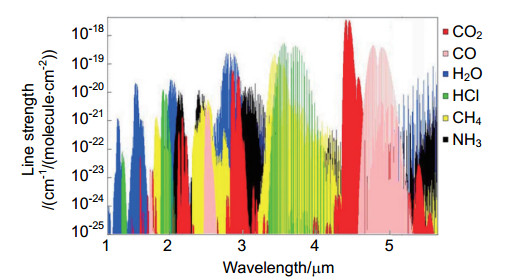
 下载:
下载:




